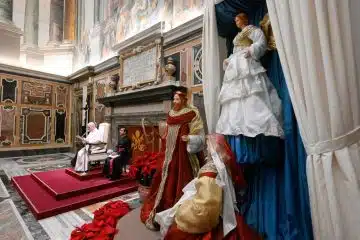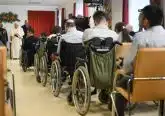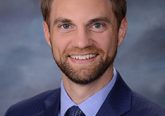Inclusive classrooms are part of Catholic schools
January 31, 2011
By David Eck
ARCHDIOCESE — At Chaminade Julienne High School in Dayton the six students with cognitive disabilities at the school spend much of their day in standard classrooms learning side-by-side with their peers and keeping up with the class work as they are able.
The school’s two intervention specialists help them as needed and teach them some subjects in smaller, modified classes. Regardless of the setting, the students are challenged to reach their fullest potential.
“I want to continue to push them and have them achieve,” said Judi MacLeod, director of special education at CJ. “Our goal is that as part of our school…everybody is a lifelong learner.”
 |
| Teacher Mike Davis works with Jeffery Wolber during an eighth-grade religion class at St. Ignatius School in Monfort Heights. Also pictured from left are Sarah Evans and Meridith Weidner. (Courtesy photo) |
Inclusion of students with significant cognitive disabilities, which are marked by significant limitation in intellectual function and adaptive behavior, is today the norm at many Catholic schools. There are nearly 70 students with cognitive disabilities and 2,700 students with learning or other disabilities enrolled in Catholic schools in the Cincinnati archdiocese. The students are in both elementary and high schools.
Over the years, legislation has prompted inclusion in schools. The federal Individual with Disabilities Education Improvement Act (IDEIA), which has its roots in the 1970s and was reauthorized in 2004, says every child has a right to a free, appropriate public education.
The goal is for every child to have access to the general curriculum in the least restrictive environment as much as possible, said Jan Kennedy, an assistant superintendent in the archdiocesan Catholic Schools Office.
“That law doesn’t really apply to our schools, but it’s the spirit of the law that we certainly have tried to incorporate. Kids [who] want a Catholic education are really not to be excluded for academic reasons alone,” Kennedy said. “If you look at the policy of the archdiocese in terms of our schools, they are to be inclusive.”
The legislation provides special education services to Catholic schools as a group entitlement based on the number of students with certain disabilities enrolled. The public school district, in consultation with the Catholic or non-public school, determines which services will be provided to which students. Funding is allocated to public school districts, which use the money to provide the services, Kennedy explained. Students with disabilities are identified through their public school district by testing and evaluation with a process called Child Find.
In the Cincinnati archdiocese, Catholic schools report the number of identified students enrolled to the archdiocese, which then compares numbers with the public school districts. It’s important that the Catholic schools receive the services for which their students are eligible. Specialists funded with federal money are public school district employees, but some Catholic schools hire their own intervention specialists to enhance those received from the public district, Kennedy said.
“The cost of special education is very high and so many of our schools, which are already struggling financially, cannot absorb the cost of providing full service, everything that a kid would need,” Kennedy said. “Parents generally have to know that they are often foregoing some of the services for which they would be eligible in a public school system in order to be in a [Catholic school].”
Still, students with autism, cognitive disabilities or other learning disabilities have the right to a Catholic education if that is what they want, noted Kennedy. Including all students in a general education classroom benefits everyone, she said.
“Inclusion works better for all kids,” Kennedy explained. “They learn from one another. If you have kids with different strengths and weaknesses, it’s kind of like a puzzle. They fill one another’s needs and kids will do that.
“They learn the value of diversity,” she added. “They learn the value of tolerance. They learn the value of helping others.”
Everyone does better academically because the teacher has to differentiate instruction and use different teaching modalities to challenge each student. Inclusion requires teachers to address kids individually, she said.
At St. Lawrence School in Price Hill, one junior high school class has had an autistic student since kindergarten. The other children bonded with him early on and have always watched out for him.
“Today he’s just one of the crowd,” said Alma Lee Joesting, principal. “He is socially accepted by the kids, and they have respect for the things that he can do.”
Inclusion allows St. Ignatius School in Monfort Heights to be true to the Catholic faith and treat people with dignity, said Tim Reilly, principal. The school has four students with autism and five with cognitive disabilities, Reilly said.
“It just brings out the best in people,” he said. “It’s a great environment.”
Teaching in inclusive classrooms requires innovative teaching methods, Reilly said. Instead of lecturing, teachers will use graphics or items that can be touched or held. Spelling words could be cheered out or sung. Facts might be presented using shaving cream so students with disabilities can use smell to learn the information.
The teachers at St. Ignatius are active in their professional growth and eight teachers have taken additional training to earn special education licenses, Reilly said. There are about 20 members on the school’s support team, including intervention specialists, instructional specialists, speech and language therapists and teacher aides.
“The needs the kids have inspire the teachers to keep learning,” Reilly said. “It just builds great teamwork.”
David Eck can be reached at: [email protected].












